Greg, dont do any more work for now. I am making more system changes that will require new mdat's.
Take a breather, relax 😀
Take a breather, relax 😀
We could always go for less correction on top and more on the LF end if needed.
But I bet target curves is a lot of fun to play with too, though I am a bit sceptic to curves that bend the way we have here...
A purely theoretical exercise shows that DRC can indeed remove the effects of second order filters:

I'd not advise this for a listening tests but it shows it can be done...
The above was done with a 10 cycle template.
But I bet target curves is a lot of fun to play with too, though I am a bit sceptic to curves that bend the way we have here...
A purely theoretical exercise shows that DRC can indeed remove the effects of second order filters:
I'd not advise this for a listening tests but it shows it can be done...
The above was done with a 10 cycle template.
Attachments
Last edited:
jim1961: Will you at least be listening for the difference of the recently provided filters before making the changes? I'm interested in what you'll hear.
wesayso: I agree about the targets; I like a straight line either flat or slightly tilted down.
wesayso: I agree about the targets; I like a straight line either flat or slightly tilted down.
jim1961: Will you at least be listening for the difference of the recently provided filters before making the changes? I'm interested in what you'll hear.
wesayso: I agree about the targets; I like a straight line either flat or slightly tilted down.
No. The changes I am making now are room acoustic ones that cant be undone easily.
Sorry for this. I made a discovery this morning I didnt expect to make.
Whatever strategies you applied to the former, you can apply after I get new measurements. I will not let your ideas go unlistened to 🙂
Last edited:
We could always go for less correction on top and more on the LF end if needed.
But I bet target curves is a lot of fun to play with too, though I am a bit sceptic to curves that bend the way we have here...
A purely theoretical exercise shows that DRC can indeed remove the effects of second order filters:

I'd not advise this for a listening tests but it shows it can be done...
The above was done with a 10 cycle template.
This looks familiar then:
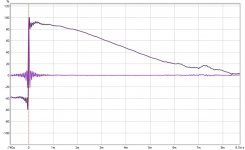
but happens to be measured response.
FR and phase:
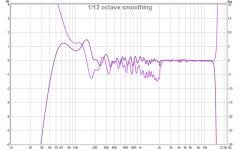
GD in practice can be just about anything:
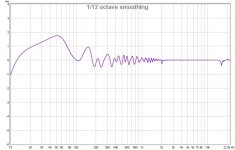
See more:
http://www.diyaudio.com/forums/multi-way/269936-cardioid-sum-monopole-dipole-speakers.html
Speaker does good square waves 200Hz-3kHz and does a fair job well off axis too. But significant SPL limitations as well. Reproduction of voice and acoustical instruments is superb.
I'm getting there myself... still have some work to do but if I manage I will have the SPL and dynamics too. Slowly closing in, but I'm convinced about getting the timing right.

Still have to work on the wiggles, measurement at 3 meter. Wiggles might be hard to avoid though with arrays...

Still have to work on the wiggles, measurement at 3 meter. Wiggles might be hard to avoid though with arrays...
Last edited:
This looks familiar then:
View attachment 485021
but happens to be measured response.
FR and phase:
View attachment 485022
GD in practice can be just about anything:
View attachment 485023
See more:
http://www.diyaudio.com/forums/multi-way/269936-cardioid-sum-monopole-dipole-speakers.html
Speaker does good square waves 200Hz-3kHz and does a fair job well off axis too. But significant SPL limitations as well. Reproduction of voice and acoustical instruments is superb.
This is really impressive what can be done with DRC. So would my 10F/RS225 FAST system be a good candidate to get these kinds of results? Can the DRC be applied in stereo before being applied to miniDSP 2x4 which handles the XO and basic EQ? Or do I have to get a dedicated 4ch sound card and let the PC with DRC handle all aspects including XO and FIR filters?
Speaker does good square waves 200Hz-3kHz and does a fair job well off axis too. But significant SPL limitations as well. Reproduction of voice and acoustical instruments is superb.
Nice work here. I noticed a link to this from SL's site a while ago. I think I would describe my little (monopole, fullrange) hypercube speakers (with DRC correction applied) similarly...
This is really impressive what can be done with DRC. So would my 10F/RS225 FAST system be a good candidate to get these kinds of results? Can the DRC be applied in stereo before being applied to miniDSP 2x4 which handles the XO and basic EQ? Or do I have to get a dedicated 4ch sound card and let the PC with DRC handle all aspects including XO and FIR filters?
The standard use for DRC would be to measure the response (using finished speakers) at the listening position and generate a speaker/room correction file based on that. However, If I were to consider building a no compromise multi-way setup, I might be tempted to try using DRC to make convolver files for each individual driver (based on nearfield/gated measurements) and use 4 channels of conversion/amplification for playback.
We could always go for less correction on top and more on the LF end if needed.
But I bet target curves is a lot of fun to play with too, though I am a bit sceptic to curves that bend the way we have here...
A purely theoretical exercise shows that DRC can indeed remove the effects of second order filters:

I'd not advise this for a listening tests but it shows it can be done...
The above was done with a 10 cycle template.
On second thought... it wouldn't hurt to try....
Greg, shall I send you the edited Normal template so you can mix Jim another song for the next round (after the new measurements are done)?
Here is what I have been up to. New FR for R+L+Subs at 1/2 oct smoothing (to best see the new tilt) and 1/24th oct.
New = Green
Old = Orange
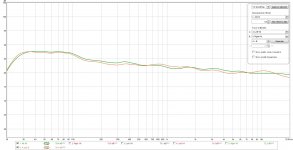
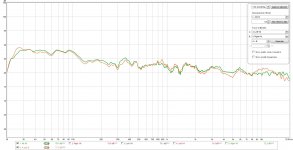
I don't want to post the new mdats until I am quite sure that this will keep for a while. Dont want Greg's work to get flushed again.
>50 hz, all these changes were accomplished acoustically. Exponentially harder to do than pressing buttons on a DRC or DSP.
I wanted to get a better tilt. Flatten the >4k response. Add some output in the 100 - 300hz area. And tilt the midrange.
New = Green
Old = Orange


I don't want to post the new mdats until I am quite sure that this will keep for a while. Dont want Greg's work to get flushed again.
>50 hz, all these changes were accomplished acoustically. Exponentially harder to do than pressing buttons on a DRC or DSP.
I wanted to get a better tilt. Flatten the >4k response. Add some output in the 100 - 300hz area. And tilt the midrange.
Last edited:
On second thought... it wouldn't hurt to try....
Greg, shall I send you the edited Normal template so you can mix Jim another song for the next round (after the new measurements are done)?
Sure, I'll take a look, but I think he'll want to be at the other end of the windowing spectrum at least in the beginning.
Here is what I have been up to. New FR for R+L+Subs at 1/2 oct smoothing (to best see the new tilt) and 1/24th oct.
New = Green
Old = Orange
View attachment 485116
View attachment 485117
I don't want to post the new mdats until I am quite sure that this will keep for a while. Dont want Greg's work to get flushed again.
>50 hz, all these changes were accomplished acoustically. Exponentially harder to do than pressing buttons on a DRC or DSP.
I wanted to get a better tilt. Flatten the >4k response. Add some output in the 100 - 300hz area. And tilt the midrange.
This looks like good work. I like to use only as strong of a DRC correction as is really needed.
Sure, I'll take a look, but I think he'll want to be at the other end of the windowing spectrum at least in the beginning.
I won't suggest it as a permanent solution but it could give a taste of time coherence. It's just one more song to listen to after all...
Sure, I'll take a look, but I think he'll want to be at the other end of the windowing spectrum at least in the beginning.
This looks like good work. I like to use only as strong of a DRC correction as is really needed.
That is the way to go. I am approximately within +/-2db of the DRC curve now.
Once I am sure I am not going to change things for a while, I look forward to hearing the 3 cycle adjustments.
Might throw in a 2 cycle, just for kicks.
I had a thought. Rather than make a room mdat from a fixed mic position dead center to derive left and right, might it be more accurate to take the left mesurement from where the left ear is, and the same for the right?

For illustration, use the black for left, red for right, instead of green for both?

For illustration, use the black for left, red for right, instead of green for both?
You need a mannequin head in order to capture the acoustics like a head of that is what you are trying to achieve. You might want to try an XY mic config where left is aimed 45deg to right and right is 45deg to the left. Both mics at same position.
You need a mannequin head in order to capture the acoustics like a head of that is what you are trying to achieve. You might want to try an XY mic config where left is aimed 45deg to right and right is 45deg to the left. Both mics at same position.
No. Just thinking about the mic location for the mdats used for DRC correction.
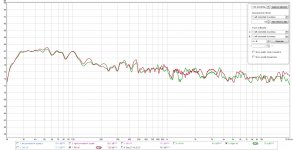
Here is my FR from the right channel at the middle position vs where the right ear is.
(red = at right ear, green = middle position)
3" makes a difference.
Last edited:
This brings me to further thoughts.
If we are trying to refine and improve the results obtained via DRC, I think we need to look carefully at how we acquire the room mdats. The room mdats are the blueprint that DRC operates from. If these are flawed or inaccurate, so will be the derived corrections.
A few things to consider in addition to my above post.
Do we keep the listening chair in place?
Do we aim the mic at the speakers or point it strait up? (using the corresponding 0 or 90 degree cal files of course)
Do we aim the mic strait ahead? (most dont have 30 degree cal files though)
Just more food for thought.
If we are trying to refine and improve the results obtained via DRC, I think we need to look carefully at how we acquire the room mdats. The room mdats are the blueprint that DRC operates from. If these are flawed or inaccurate, so will be the derived corrections.
A few things to consider in addition to my above post.
Do we keep the listening chair in place?
Do we aim the mic at the speakers or point it strait up? (using the corresponding 0 or 90 degree cal files of course)
Do we aim the mic strait ahead? (most dont have 30 degree cal files though)
Just more food for thought.
Since each speaker is being heard with both ears, the standard single location technique makes the most sense to me. The difference between the center location and either ear (~4") shouldn't really make a difference anyhow unless a long window is used during the correction.
I actually do point the mic directly at each speaker (keeping the capsule in the same spatial location), although I don't think 30 deg off axis is a big deal for a typical measurement mic.
I actually do point the mic directly at each speaker (keeping the capsule in the same spatial location), although I don't think 30 deg off axis is a big deal for a typical measurement mic.
I'd say it would be better to include your mic cal to the correction. Exported impulses from REW don't include the mic correction, so you'd have to do that within DRC.
- Status
- Not open for further replies.
- Home
- Loudspeakers
- Full Range
- Group Delay Questions and Analysis
